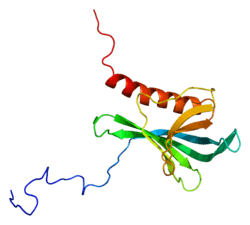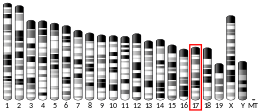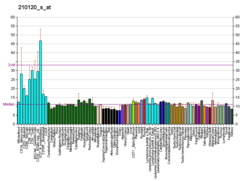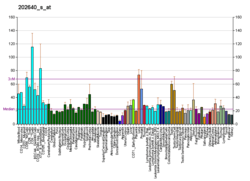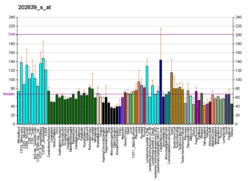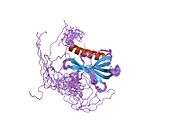RANBP3
Ran-binding protein 3 is a protein that in humans is encoded by the RANBP3 gene.[5][6]
This gene encodes a protein with a RanBD1 domain that is found in both the nucleus and cytoplasm. This protein plays a role in nuclear export as part of a heteromeric complex. Alternate transcriptional splice variants, encoding different isoforms, have been characterized.[6]
Interactions
RANBP3 has been shown to interact with RCC1[5][7] and XPO1.[8][9]
gollark: Steal them from https://i.osmarks.net/memes-or-something instead.
gollark: Oh no.
gollark: Here is a meme.
gollark: Worrying.
gollark: This is very easy to calculate, fortunately.
References
- GRCh38: Ensembl release 89: ENSG00000031823 - Ensembl, May 2017
- GRCm38: Ensembl release 89: ENSMUSG00000002372 - Ensembl, May 2017
- "Human PubMed Reference:". National Center for Biotechnology Information, U.S. National Library of Medicine.
- "Mouse PubMed Reference:". National Center for Biotechnology Information, U.S. National Library of Medicine.
- Mueller L, Cordes VC, Bischoff FR, Ponstingl H (July 1998). "Human RanBP3, a group of nuclear RanGTP binding proteins". FEBS Lett. 427 (3): 330–6. doi:10.1016/S0014-5793(98)00459-1. PMID 9637251.
- "Entrez Gene: RANBP3 RAN binding protein 3".
- Nemergut, Michael E; Lindsay Mark E; Brownawell Amy M; Macara Ian G (May 2002). "Ran-binding protein 3 links Crm1 to the Ran guanine nucleotide exchange factor". J. Biol. Chem. 277 (20): 17385–8. doi:10.1074/jbc.C100620200. ISSN 0021-9258. PMID 11932251.
- Lindsay, M E; Holaska J M; Welch K; Paschal B M; Macara I G (June 2001). "Ran-binding protein 3 is a cofactor for Crm1-mediated nuclear protein export". J. Cell Biol. 153 (7): 1391–402. doi:10.1083/jcb.153.7.1391. ISSN 0021-9525. PMC 2150735. PMID 11425870.
- Lindsay, Mark E; Plafker Kendra; Smith Alicia E; Clurman Bruce E; Macara Ian G (August 2002). "Npap60/Nup50 is a tri-stable switch that stimulates importin-alpha:beta-mediated nuclear protein import". Cell. 110 (3): 349–60. doi:10.1016/S0092-8674(02)00836-X. ISSN 0092-8674. PMID 12176322.
Further reading
- Maruyama K, Sugano S (1994). "Oligo-capping: a simple method to replace the cap structure of eukaryotic mRNAs with oligoribonucleotides". Gene. 138 (1–2): 171–4. doi:10.1016/0378-1119(94)90802-8. PMID 8125298.
- Suzuki Y, Yoshitomo-Nakagawa K, Maruyama K, et al. (1997). "Construction and characterization of a full length-enriched and a 5'-end-enriched cDNA library". Gene. 200 (1–2): 149–56. doi:10.1016/S0378-1119(97)00411-3. PMID 9373149.
- Lindsay ME, Holaska JM, Welch K, et al. (2001). "Ran-binding protein 3 is a cofactor for Crm1-mediated nuclear protein export". J. Cell Biol. 153 (7): 1391–402. doi:10.1083/jcb.153.7.1391. PMC 2150735. PMID 11425870.
- Englmeier L, Fornerod M, Bischoff FR, et al. (2002). "RanBP3 influences interactions between CRM1 and its nuclear protein export substrates". EMBO Rep. 2 (10): 926–32. doi:10.1093/embo-reports/kve200. PMC 1084078. PMID 11571268.
- Nemergut ME, Lindsay ME, Brownawell AM, Macara IG (2002). "Ran-binding protein 3 links Crm1 to the Ran guanine nucleotide exchange factor". J. Biol. Chem. 277 (20): 17385–8. doi:10.1074/jbc.C100620200. PMID 11932251.
- Strausberg RL, Feingold EA, Grouse LH, et al. (2003). "Generation and initial analysis of more than 15,000 full-length human and mouse cDNA sequences". Proc. Natl. Acad. Sci. U.S.A. 99 (26): 16899–903. Bibcode:2002PNAS...9916899M. doi:10.1073/pnas.242603899. PMC 139241. PMID 12477932.
- Hakata Y, Yamada M, Shida H (2003). "A multifunctional domain in human CRM1 (exportin 1) mediates RanBP3 binding and multimerization of human T-cell leukemia virus type 1 Rex protein". Mol. Cell. Biol. 23 (23): 8751–61. doi:10.1128/MCB.23.23.8751-8761.2003. PMC 262658. PMID 14612415.
- Ota T, Suzuki Y, Nishikawa T, et al. (2004). "Complete sequencing and characterization of 21,243 full-length human cDNAs". Nat. Genet. 36 (1): 40–5. doi:10.1038/ng1285. PMID 14702039.
- Grimwood J, Gordon LA, Olsen A, et al. (2004). "The DNA sequence and biology of human chromosome 19". Nature. 428 (6982): 529–35. Bibcode:2004Natur.428..529G. doi:10.1038/nature02399. PMID 15057824.
- Gerhard DS, Wagner L, Feingold EA, et al. (2004). "The status, quality, and expansion of the NIH full-length cDNA project: the Mammalian Gene Collection (MGC)". Genome Res. 14 (10B): 2121–7. doi:10.1101/gr.2596504. PMC 528928. PMID 15489334.
- Rual JF, Venkatesan K, Hao T, et al. (2005). "Towards a proteome-scale map of the human protein-protein interaction network". Nature. 437 (7062): 1173–8. Bibcode:2005Natur.437.1173R. doi:10.1038/nature04209. PMID 16189514.
- Olsen JV, Blagoev B, Gnad F, et al. (2006). "Global, in vivo, and site-specific phosphorylation dynamics in signaling networks". Cell. 127 (3): 635–48. doi:10.1016/j.cell.2006.09.026. PMID 17081983.
- Ewing RM, Chu P, Elisma F, et al. (2007). "Large-scale mapping of human protein-protein interactions by mass spectrometry". Mol. Syst. Biol. 3 (1): 89. doi:10.1038/msb4100134. PMC 1847948. PMID 17353931.
This article is issued from Wikipedia. The text is licensed under Creative Commons - Attribution - Sharealike. Additional terms may apply for the media files.
